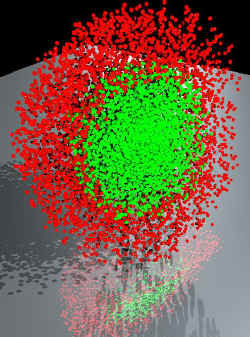Apply Quantum Principle with Caution

In the early 20th century physicists realized that classical physics fails to explain atoms, even though it works well for baseballs and planets. Part of the early atomic theory relied on Niels Bohr’s correspondence principle, which states that the quantum theory must agree with the classical theory in situations where the classical theory is accurate. For atoms, the classical limit has always meant highly excited energy states, in which the energy spacing between quantum states is so small as to resemble the continuum of states predicted by Newtonian physics. While this idea works well for some special cases like the hydrogen atom, a paper in the 22 November PRL shows that high-energy states are not necessarily classical, so Bohr’s commonly-used formulation of the principle is not correct in general.
Bohr’s original 1913 model of the hydrogen atom was based in part on his correspondence principle: When the electron is far from the proton–say, a meter away–it should act like a classical charge, emitting light with the same frequency that it orbits the proton. It worked famously for Bohr, and the principle was formalized and extended over the years. Today textbooks state that classical and quantum theories must agree for large quantum numbers, and many researchers expect all atomic calculations at large quantum numbers to agree with Bohr-like “semiclassical” predictions.
Bo Gao of the University of Toledo in Ohio was studying the rotational-vibrational states of diatomic molecules close to breaking apart and was surprised that the semiclassical predictions became less accurate at higher quantum numbers. The problem, Gao eventually realized, is that a state with a large quantum number is not necessarily “more classical”–the correct classical limit is a state where the quantum mechanical wave associated with the particles has a short wavelength.
Ultracold atoms can have extremely long wavelengths, so even if a pair of them attract one another at a great distance–equivalent to a molecule in a highly excited vibrational state–the semiclassical theory might still not apply. Neutral atoms do not attract one another as strongly as oppositely charged particles, which follow the Coulomb inverse-square law. Gao found that most commonly studied atomic force laws–such as the van der Waals interaction–fail to follow Bohr’s version of the correspondence principle.
“We did not have a good quantum theory for those very highly excited states of molecules,” says Gao, so most researchers use complex computer codes to calculate their properties. He explains that without a more direct theory, the semiclassical approach has remained popular “because it’s a very simple result.” Gao maintains that both physics teachers and researchers need to clarify their understanding of the correspondence principle.
“Fortunately, Bohr picked the Coulomb potential for his first study,” notes Chris Greene of the University of Colorado at Boulder, because it’s one of the few cases where Bohr’s formulation of the correspondence principle works. He says that others studying cold atoms in the past several years have noticed the problem in different guises. As physicists learn more, Greene adds, “the more remarkable it seems that the line of research Bohr initiated led ultimately to the correct quantum mechanical theory.”
More Information
Two short Comments in the 19 March 2001 PRL dispute this paper: C. Eltschka et al., Phys. Rev. Lett. 86, 2693 (19 March 2001) C. Boisseau et al., Phys. Rev. Lett. 86, 2694 (19 March 2001)


